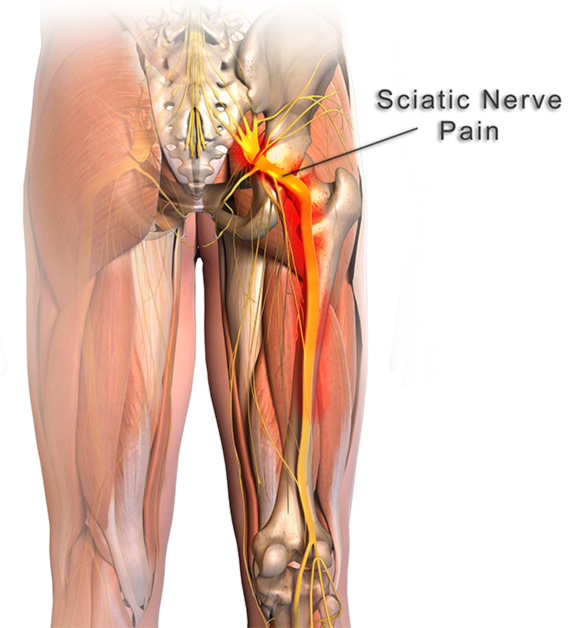Health
All You Need To Know About Sciatica
Sometimes it is really hard to identify the source of your back pain, however, other times you can just pinpoint it easily. And Sciatica is one of those that is pretty simple to identify.
The pain can become worse when a patient cough, sneeze, or a cough. Symptoms of Sciatica can develop gradually or can occur suddenly. Probably one can feel numbness, weakness, or tingling or a burning sensation in their leg. Very rare symptoms also include the inability of movement of the food and bending the knee.
The Sciatic Nerve & Sciatica
The sciatic nerve is the largest single nerve in our body and it is made up of individual nerve roots which start by branching out from the spine in the lower back and combine to form the “sciatic nerve.” The symptoms of Sciatica occur when the large sciatic nerve is compressed or irritated at or near its point of origin. It starts in the lower back, typically at lumbar segment 3.
- At each of the level of your lower spine, there is nerve root which exits from the inside of spinal canal, and each of the respective nerve roots will then come together to form the large sciatic nerve.
- The sciatic nerve runs from lower back, through the buttock, and then down the back of each leg.
- The portions of sciatic nerve then branch out in each of the legs to innervate certain parts of the leg—the thigh, calf, foot, and toes.
What causes sciatica?
Sciatica can be a symptom of “pinched nerve” which can possibly affect one or more lower spinal nerves. So nerve might be pinched outside or inside of your spinal while passing into the leg.

Conditions that cause sciatica:
- A slipped or herniated disc which can cause pressure on the nerve root. Hence, this plays as the most common cause of the Sciatica.
- Piriformis syndrome develops when the piriformis muscle (small muscle which lies under the buttocks) becomes spasms or tight and put pressure, irritating the sciatic nerve.
- Spinal stenosis is a condition which results from the narrowing of spinal canal from the pressure on the nerves.
- Spondylolisthesis is a slippage of the one vertebra which is out of line with the one above it that makes narrowing the opening through the nerve exits.
How is sciatica diagnosed?
An entire therapeutic history, including an audit of your side effects, and a physical exam can help the health care providers analyze sciatica and decide its cause. For instance, he or she may play out a straight-leg-raise test. In which you lie on your back with your legs straight. The health care provider will gradually raise every leg and note the height at which your pain starts. So This test can help pinpoint the influenced nerves and decide whether there is an issue with one of your plates.
Other diagnostic tests should be performed to search for different reasons for sciatic pain. Therefore the contingent will be upon what your health care provider discovers, he or she may prescribe additionally testing. Such testing may include:
- X-ray to check fractures in the spine
- Magnetic resonance imaging (MRI) or computed tomography (CT) scan to create the images of structures of the back
- Nerve conduction velocity studies/electromyography to examine how well electrical impulses travel through the sciatic nerve
- Myelogram using dye injected between vertebrae to determine if a vertebra or disc is causing the pain

Notwithstanding, most patients with sciatica can get treatment without the requirement for further demonstrative testing.
Treatments for sciatica
The objective of treatment is to diminish pain and increase versatility. Treatment frequently incorporates constrained rest (on a solid sleeping pad or on the floor), physical therapy, and the utilization of medicine to treat pain and irritation. An altered physical therapy practice program may need.
Pain medicines and anti-inflammatory drugs
They help to soothe pain and solidness, considering expanded portability and exercise. There are numerous normal over-the-counter medicines called non-steroidal anti-inflammatory drugs (NSAIDs). They incorporate headache medicine, ibuprofen (Motrin, Advil), and naproxen (Naprosyn, Aleve).
Muscle relaxants
For example, cyclobenzaprine (Flexeril), may be recommended to alleviate the uneasiness related with muscle fits. Be that as it may, these medicines may bring about perplexity in more seasoned individuals. Contingent upon the level of pain, pain medicines will be a part of the underlying time of treatment.
Physical therapy
The objective of physical therapy is to discover practice developments that decrease sciatic pain by lessening the weight on the nerve. In fact, a program of activity frequently incorporates extending activities to enhance the adaptability of tight muscles and oxygen consuming activity, let’s say, strolling.
The specialist may likewise prescribe activities to fortify the muscles of your back, stomach area, and legs.
Spinal infusions
An infusion of a cortisone-like anti-inflammatory medicine into the lower back might help lessen swelling and aggravation of the nerve roots, taking into account expanded versatility.
Surgery
Surgery will need for individuals who don’t react to traditional treatment, who have advancing symptoms and are encountering extreme pain.
Surgical options include:
- Microdiscectomy is a procedure which helps in removing the fragments of a herniated disc.
- Laminectomy — in this procedure, the bone which curves around and covers the spinal cord (lamina), and the tissue which is causing the pressure on the sciatic nerve should be removed.

The belief of many people includes that yoga or acupuncture will improve sciatica. But Massage may help the muscle spasms which often occur with sciatica. Furthermore, the Medical advice is necessary to help yourself with managing the pain and relieve stress in this condition. It can affect the ability to cope with pain.





Please madom I am very excited about my back pain left side leg it’s very burn 3 time mri & all nurv reports is normal please help me
Hi sudam the best thing you can do is consult a physiotherapist I guess it will be of great help to you and also start using Inlife Glucosamine with msm for pain reliving
https://www.inlifehealthcare.com/shop/glucosamine-msm-tablets/